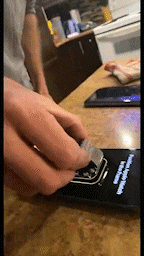A TikTok came across my FYP (For You Page) recently that illustrated one of my favorite sayings about behavioral science-powered customer experience:

Watch what customers do, not what they say they do.
You can see from the gif of the full video that this user, whose iPhone has asked him to “position Apple Watch in frame,” is putting the watch face down in the prompted rectangle.
What the user is supposed to be doing is lifting up his phone and using the rear camera to scan the Apple Watch.
The on-screen rectangle is a guide to how far out you should hold the phone. But that’s not how this user understood the experience.
This TikTok shows us how important user testing is, but it also shows how important it is to observe customers rather than relying on interviews, focus groups, verbatim, and other forms of asking people what they do or what they WILL do in the future.
Why Observe Instead of Asking?
There are two reasons why observation is a better tool than simply interviewing users:
- Behavioral Science says that people often aren’t aware of what’s really motivating them, and when asked will run their reasons through internal filters that can distort the truth.
- We know from experience as marketers and customer experience designers, that people don’t always do what we intend for them to do. We observe to discover what users are really doing — not what they’re reporting they’re doing.
If you’re new to customer (or user) observation and want to try it out for yourself, keep a few things in mind:
- Observe without judgment.
- Don’t fall into the “small numbers” trap — the customers you observe are a small sample of your total users.
- Wait to define insights until you have enough objective information.
🚀 Learn what makes buyers tick
Join 8k+ of world's best marketers from brands like Disney, Coca-Cola, Google who are learning marketing psychology in <5 mins a week.
AEIOU: A Simple User Research Tool
Developed by ethnographic researchers, the AEIOU framework gives us a framework to structure observations “in the field.” It’s often used by UX researchers (and other types of qualitative researchers) to watch what people are doing and make sense of it.
Each letter stands for one of five related elements:
A: Activities
These are the actions people take toward the goals they want to accomplish. For example, if you want to order a product on Amazon, one activity might be searching the site. If you’re trying to order a meal at a fast food restaurant, an activity might be using a digital kiosk to find your favorite burger.
E: Environments
These are the contexts in which an activity is taking places. For example, if you’re ordering an item on Amazon on your phone you might be sitting on your couch at the end of a long day, feeling too tired to run to the store. If you’re ordering a meal in a fast food drive thru, you might be juggling requests from your kids in the backseat while sitting in a long line waiting to order.
I: Interactions
These are the routines and exchanges between your users/customers and the environment. For example, if you’re calling to order a pizza you’re interacting with the person who picks up the phone. If you use a deliver app like Uber Eats to order a pizza, you’re interacting with the app.
O: Objects
These are key elements of environments. For example, a brochure you download from a website before booking a vacation or a poster for a new sandwich at a chain restaurant.
U: Users
These are the people who are being observed.
A Free Worksheet to Try Out AEIOU for Yourself
Want to try this simple exercise? I’ve put together a free quick-start AEIOU worksheet. This will help you easily observe, document, and develop insights from existing customer behaviors.
You can download it here for free.
